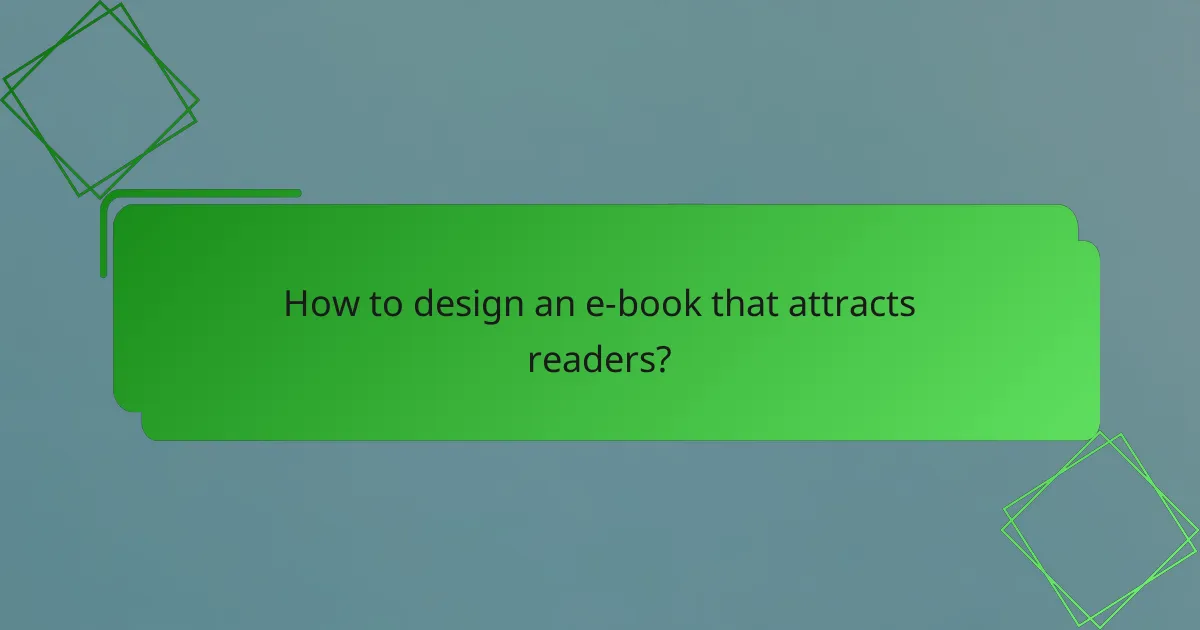E-books have transformed the way we consume information, requiring a thoughtful approach to structure, engagement, and design. By prioritizing clear organization and incorporating interactive elements, authors can create a captivating reading experience that enhances comprehension and retention. Additionally, an engaging layout and multimedia content not only attract readers but also foster a deeper connection with the material.

How to structure an e-book for maximum impact?
To structure an e-book effectively, focus on clear organization, engaging design, and interactive elements that enhance reader experience. A well-structured e-book not only captures attention but also facilitates comprehension and retention of information.
Clear chapter organization
Organizing chapters logically is crucial for guiding readers through your e-book. Start with an introduction that outlines the main themes, followed by chapters that build on each other in a coherent manner. Consider using a table of contents for easy navigation.
Each chapter should have a clear focus, ideally covering one main topic or idea. This helps readers absorb information without feeling overwhelmed. Aim for a consistent length across chapters, typically between 1,500 to 3,000 words, to maintain a uniform reading experience.
Effective use of headings
Headings play a vital role in breaking up text and improving readability. Use descriptive headings to summarize the content of each section, making it easier for readers to scan and find relevant information. Hierarchical headings (H1, H2, H3) should reflect the structure of your content.
Limit the number of headings per chapter to avoid clutter, and ensure they are consistent in style and formatting. This not only enhances visual appeal but also aids in the logical flow of information.
Incorporation of visuals
Visuals such as images, infographics, and charts can significantly enhance the engagement level of your e-book. They help illustrate complex concepts and break up large blocks of text, making the content more digestible. Aim to include visuals that complement the text rather than distract from it.
When using visuals, ensure they are high-quality and relevant to the content. Consider including captions to explain their significance, and maintain a consistent style throughout the e-book to create a cohesive look.
Consistent formatting
Consistency in formatting is key to a professional-looking e-book. Use the same font styles, sizes, and colors throughout the document to create a unified appearance. This includes headings, body text, and any other elements like bullet points or numbered lists.
Establish a style guide for your e-book that outlines these formatting choices. This will help maintain uniformity and make it easier to edit and update content in the future.
Interactive elements
Incorporating interactive elements can greatly enhance reader engagement. Consider adding hyperlinks, quizzes, or embedded videos that encourage readers to interact with the content. This not only makes the reading experience more enjoyable but also reinforces learning.
Ensure that interactive features are user-friendly and accessible across different devices. Test these elements thoroughly to avoid technical issues that could frustrate readers and detract from their experience.

What are the best practices for engaging e-book content?
Engaging e-book content combines compelling storytelling, multimedia elements, and reader feedback to create an immersive experience. By focusing on these aspects, authors can enhance reader retention and satisfaction.
Compelling storytelling techniques
Effective storytelling in e-books captivates readers and keeps them invested in the narrative. Techniques such as character development, conflict, and resolution are essential, as they create emotional connections and drive the plot forward.
Utilizing cliffhangers or thought-provoking questions at the end of chapters can encourage readers to continue. Incorporating relatable themes and personal anecdotes can also enhance engagement, making the content more memorable.
Use of multimedia elements
Integrating multimedia elements like images, videos, and audio can significantly boost engagement in e-books. Visuals can illustrate complex ideas, while videos can provide deeper insights or demonstrations related to the text.
Consider using interactive features, such as quizzes or clickable infographics, to make the reading experience more dynamic. However, ensure that multimedia elements are relevant and do not distract from the core message of the e-book.
Incorporation of reader feedback
Incorporating reader feedback is crucial for refining e-book content and enhancing engagement. Encourage readers to share their thoughts through surveys or comment sections, which can provide valuable insights into their preferences and experiences.
Regularly updating the e-book based on feedback can demonstrate responsiveness and commitment to quality. This practice not only improves the current edition but also fosters a sense of community among readers, increasing their investment in future works.

How to design an e-book that attracts readers?
To design an e-book that attracts readers, focus on creating an engaging layout, ensuring compatibility across devices, and maintaining a consistent brand identity. These elements work together to enhance the reading experience and keep your audience interested.
Visual appeal through design
Visual appeal is crucial in e-book design, as it can significantly influence a reader’s first impression. Use high-quality images, a cohesive color palette, and readable fonts to create an inviting aesthetic. Aim for a clean layout that balances text and visuals, avoiding clutter that can distract from the content.
Consider incorporating elements like infographics or pull quotes to break up text and highlight key points. This not only enhances engagement but also aids in information retention. Remember to ensure that all visual elements are optimized for digital formats to maintain quality across various devices.
Responsive layout for devices
A responsive layout is essential for ensuring your e-book is accessible on various devices, including smartphones, tablets, and e-readers. Design your e-book using flexible grids and scalable images that adapt to different screen sizes. This approach enhances readability and user experience, allowing readers to engage with your content seamlessly.
Test your e-book on multiple devices to identify any formatting issues. Tools like Adobe InDesign or online e-book converters can help you create a responsive design. Prioritize a layout that maintains readability, as overly complex designs may frustrate users and lead to disengagement.
Branding consistency
Branding consistency is vital in e-book design, as it reinforces your identity and builds trust with readers. Use your brand’s colors, fonts, and logos throughout the e-book to create a unified look. This consistency helps readers recognize your work and fosters a sense of familiarity.
Incorporate your brand’s voice in the writing style and tone to further enhance the connection with your audience. Avoid mixing different styles or formats that could confuse readers. A well-branded e-book not only attracts attention but also encourages readers to return for future content.

What tools can enhance e-book creation?
Several tools can significantly improve the e-book creation process by streamlining layout, design, and writing. Utilizing the right software can enhance both the efficiency and quality of your e-book, making it more engaging for readers.
Adobe InDesign for layout
Adobe InDesign is a powerful tool for creating professional layouts in e-books. It allows for precise control over text and image placement, making it ideal for complex designs. You can easily create multi-page documents and export them in various formats, including EPUB and PDF.
When using InDesign, consider utilizing its grid and guide features to maintain consistency throughout your e-book. Additionally, take advantage of styles for headings and body text to ensure a cohesive look. However, be mindful of the learning curve; it may take some time to master all its features.
Canva for design elements
Canva is an accessible design tool that can enhance the visual appeal of your e-book. It offers a wide range of templates, graphics, and fonts, making it easy to create eye-catching cover designs and illustrations. Canva’s drag-and-drop interface is user-friendly, allowing even beginners to produce high-quality visuals.
To maximize Canva’s potential, focus on maintaining a consistent color palette and typography throughout your e-book. This will help reinforce your brand identity. Keep in mind that while Canva is great for design, it may not be suitable for complex layout tasks, so consider pairing it with a layout tool like InDesign.
Scrivener for writing
Scrivener is an excellent writing tool designed specifically for authors and e-book creators. It allows you to organize your notes, research, and manuscript in one place, making it easier to manage large projects. Its corkboard and outliner features help you visualize the structure of your e-book.
When using Scrivener, take advantage of its export options to format your manuscript for various e-book platforms. This can save you time in the final stages of production. However, be cautious of its complexity; familiarize yourself with its features to avoid feeling overwhelmed.

What are the key criteria for selecting an e-book platform?
When selecting an e-book platform, prioritize user-friendliness, distribution options, and analytics features. These criteria ensure that both authors and readers have a seamless experience while maximizing the reach and effectiveness of the e-book.
User-friendly interface
A user-friendly interface is crucial for both authors and readers. It should allow for easy navigation, intuitive design, and straightforward uploading processes. Look for platforms that offer customizable templates and simple editing tools to enhance the overall experience.
Consider platforms that provide a mobile-friendly design, as many readers access e-books on their smartphones or tablets. A responsive layout can significantly improve engagement and satisfaction.
Distribution options
Distribution options determine how widely your e-book can reach potential readers. Choose a platform that offers multiple distribution channels, including major retailers like Amazon, Apple Books, and Google Play. This increases visibility and sales potential.
Some platforms allow for global distribution, while others may focus on specific regions. Assess your target audience and select a platform that aligns with your distribution goals, ensuring you can reach readers in your desired markets.
Analytics and reporting features
Analytics and reporting features provide valuable insights into reader behavior and sales performance. Look for platforms that offer detailed reports on downloads, reading time, and user demographics. This data can inform your marketing strategies and content adjustments.
Consider platforms that allow for real-time tracking, enabling you to respond quickly to trends or shifts in reader preferences. Effective use of analytics can enhance your e-book’s success and inform future projects.


